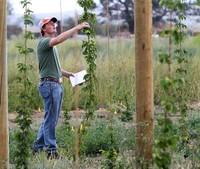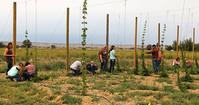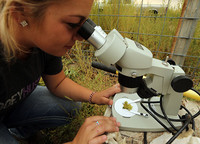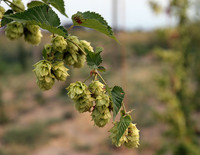Cloudy and Windy, 55° F
Northwest College ag students are digging into this potential market to find out what kind of hops grow best so that local brewers might be able to draft together plans for such a brew.
NWC is entering its second year of a three-year hops variety …
This item is available in full to subscribers.
The Powell Tribune has expanded its online content. To continue reading, you will need to either log in to your subscriber account, or purchase a subscription.
If you are a current print subscriber, you can set up a free web account by clicking here.
If you already have a web account, but need to reset it, you can do so by clicking here.
If you would like to purchase a subscription click here.
Please log in to continue |
|





NWC looks into growing hops
The Big Horn Basin is known for producing barley and sugar and for having high quality water. About all that’s missing is the hops, and the Basin could brew beer made almost entirely from locally grown ingredients.
Northwest College ag students are digging into this potential market to find out what kind of hops grow best so that local brewers might be able to draft together plans for such a brew.
NWC is entering its second year of a three-year hops variety trial project, and so far, the results are promising.
Micah Humphreys, NWC associate professor of agroecology and range management, was growing hops at his home. He knew of several locals who brew their own beer and have grown hops in their personal gardens for 25 years or more.
“I thought it would be a cool fit because we grow the barley and are in the right place — the right northern climate — to grow hops,” Humphreys said, noting that northern latitudes have longer summer days, a key component to successful hops growth. “Hops are an interesting beast.”
The trial has 10 varieties of hops that were planted in early May. As a perennial, hops come back annually and after three years they will be up for full production.
“They are labor intensive with high capital costs, but the market is very good,” Humphreys said, noting demand is highest among local breweries along with those who brew at home.
This is where WYOld West Brewing Company in Powell gets involved.
WYOld West’s part-owner and brew master Tony Wickham met Humphreys when he moved to town about a year and a half ago. It wasn’t long before the duo’s discussion turned into NWC’s hop variety trials.
“There is definitely a great future for that (hops production),” Wickham said.
Trial shows surprising results
NWC’s program started with the USDA’s Special Crops Program, which provides a grant for projects that focus on finding out the viability of specialty non-major commodity crops.
There were 200 plants growing at the college’s ag pavilion last season and an identical trial is going to be grown out near Wyo. Highway 294. This will allow for different varieties of soil to be tested and the climate is slightly different than at the pavilion.
Another difference is drip irrigation is being used at the pavilion, and the trial west of Powell will have furrow irrigation.
Northwest’s trial crop is still in the exploratory phase to find out what variety of hops works best in the region’s climate — similar to how certain types of wheat grows better in Wyoming than other varieties.
The first trial showed some surprising results with the Cascade variety of hops yielding just 50 grams of hops per plant on average. Meanwhile, the Centennial variety was at the top with nearly 300 grams of hops and Sterling was next line with about 200 grams.
“We know some will do good almost anywhere,” Humphreys said. “Centennial and Cascade do good anywhere; they are forgiving and productive.”
NWC is looking into native hops, the kind that can be found growing wild in Wyoming.
“I want to see if they have brew qualities that might be interesting to pursue in addition to what grows well here,” Humphreys said.
NWC conducted a pre-trial with the University of Wyoming Extension and learned that weather has a serious impact on which varieties will prosper on a given year, Humphreys said.
The project has three goals:
• Perform variety trials
• Gather local growers and brewers together to determine the viability of hops production in the Big Horn Basin.
• Provide some workshops such as the one scheduled for April 1 to provide general information on growing hops.
“We want to provide this as a public service to the whole scale of people interested — home brew people in town with the square footage all the way up to producers looking to diversify in the Basin,” Humphreys said.
Wickham estimated there are two or three dozen home brewers in the area, such as members of the Hop Heads group and the Park County Home Brewers.
Humphreys attended the American Hop Growers Association’s meetings this winter and learned there are many small acreages coming in with an interest in hops production.
Just like how brewing takes patience with a long-term mindset, contracting for hops production takes time. Growers contract out several years in advance and breweries are planning brews four or five years in advance to get the hops they want because the market is so tight, Humphreys said.
“It is a hops revolution in terms of small growers around the nation,” Humphreys said.
Washington, Colorado and Oregon are part of what is known as the “legacy region,” where hops have traditionally been grown in the U.S. But now other states are hopping on the hops bandwagon.
Hops grown in Washington are about 18 feet tall, but the ones grown in the Big Horn Basin are around 13-14 feet tall due to wind and the height of the poles on the trellis system.
Michigan is the first state outside the legacy region with 1,000 acres, Humphreys said. The association’s meeting was about half longtime growers from the legacy region and the other half were newcomers and small operations.
Having hops in the area would be a bit of a money-saver for breweries in the area, Wickham said. But that’s not the big draw.
“It would be a huge promotional item,” Wickham said. “We would stamp it and say ‘the barley is grown here by all of you, come and enjoy the fruits of your labor.’ And it would be great if we can add the other main ingredient, hops, to the locally grown moniker or stamp.”
How’s it done?
It all starts with planting rhizomes. Once they pop out of the ground, provide a trellis and cord system such as one made of coconut husk fiber. When several buds emerge, train them to go clockwise around the trellis system — from there it will grow around on its own.
After summer solstice, they will produce cones. All of NWC’s trial hops are female plants since the male plants do not produce the cones that are needed, Humphreys said.
The yellow portions on the green leafy parts of the cones are where the oil comes from that gives beer its aroma and bitterness.
Some varieties of hops are better for creating a bitter taste, while others are more for aroma and some do a bit of both, Humphreys said.
The biggest and most expensive part of turning hops into beer is the processing, Wickham said. Hops have to be kiln-dried to a certain moisture content, then baled and cooled or aged. From there, the most convenient form for brewing is to make them into pellets.
The hops union in the Yakima area got a small processing unit and Wickham said that could be a viable option for the Big Horn Basin area.
“It would have to be like a co-op deal,” Wickham said, noting that farmers involved with the co-op could come in and have their hops processed.
If a processing facility was in place, Wickham estimated it would be three more years before enough hops could be produced for brewers to use it.